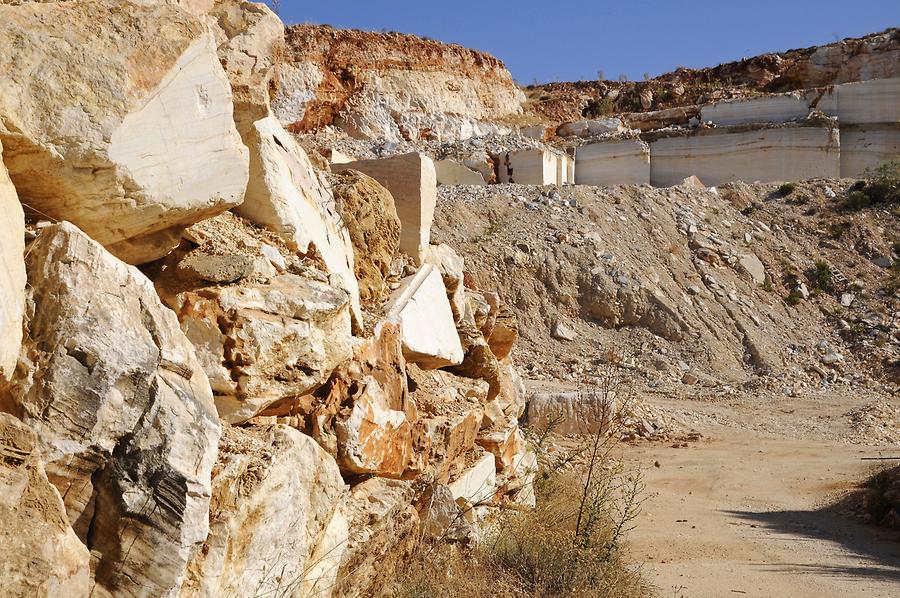Marathi - Marble Quarry; Parian Marble#

Marathi - Marble Quarry; Parian Marble, June 2010, © Gerhard Huber, under CC BY-NC 4.0 +Edu
Paros aufregendste Zeit liegt immerhin schon mehr als 2 Jahrtausende zurück. Damals baute man in Stollen rund um Marathi
Marathi , Paros
den kostbarsten Marmor der Antike ab. Seine Besonderheit ist die hohe Durchscheinfähigkeit. Wie jeder Marmor entstand auch jener aus Paros durch Metamorphose, bei der Carbonatgestein unter hohem Druck und hoher Temperatur im Erdinneren stark zusammengepresst wird. Diese Auskristallisierung erfolgte beim parischen Marmor jedoch mit außergewöhnlicher Gleichmäßigkeit, sodaß Licht selbst 3,5 cm dicke Gesteinsplatten durchdringt, wesentlich mehr als beim berühmten Carrara-Marmor. Diese besondere Lichtdurchlässigkeit machte es Künstlern schwer, die Wirkung einer Skulptur auf den Betrachter vorauszusehen. Darum versuchten sich nur die großen Meister der Antike an diesem Marmor. Daraus entstanden z.B. die Venus von Milo und die Nike von Samothrake, heute beide im Pariser Louvre zu sehen. Auch die Grabstätte von Napoelon beinhaltet Marmor aus Paros. Mystiker sahen in dem edlen Mineral sogar einen Ausdruck des Göttlichen. Viel weniger göttlich waren allerdings die Bedingungen für die Bergarbeiter in den engen, stickigen Stollen. Vom 7. vorchristlichen Jahrhundert an schufteten hier Sklaven unter erbärmlichen Bedingungen. Wahrscheinlich, so berichten zumindest die spärlichen schriftlichen Quellen, wurden in den griechischen Bergwerken der damaligen Zeit junge Knaben für den Vortrieb der Stollen eingesetzt. Nicht selten kam es vor, dass die Bergwerkssklaven angekettet arbeiten mussten. Heute lohnt der schwierige Abbau kaum noch, zumal auf den Nachbarinseln hochqualitativer Marmor im Tagbau viel kostengünstiger gewonnen werden kann.
After all, Paros´ most exciting time is already more than 2 millennia ago. At that time, the most valuable marble of antiquity was mined in tunnels around Marathi
Marathi , Paros
. Its peculiarity is the high translucency. Like every marble, the one from Paros was created by metamorphosis. In this, carbonate rock is strongly compressed under high pressure and high temperature in the interior of the earth. This crystallization, however, took place with exceptional uniformity in the Parian marble, so that light even shines through 3.5 cm thick rock slabs, much more than the famous Carrara marble. This special translucency made it difficult for artists to anticipate the effect of a sculpture on the viewer. That is why only the great masters of antiquity tried on this marble. This resulted, for example, in the Venus of Milo and the Nike of Samothrace, both now in the Paris Louvre. The tomb of Napoelon also contains marble from Paros. Mystics even saw an expression of the divine in the noble mineral. Much less divine, however, were the conditions for the miners in the narrow, stuffy tunnels. From the 7th century BC on, slaves toiled in miserable conditions. Probably, according to at least the sparse written sources, young boys were used for the advancement of the tunnels in the Greek mines of that time. It didn´t happen infrequently that the mine slaves had to work chained. Today, the difficult mining is hardly worthwhile, especially since the high-quality marble in the Tagbau can be obtained much cheaper in the neighboring islands.